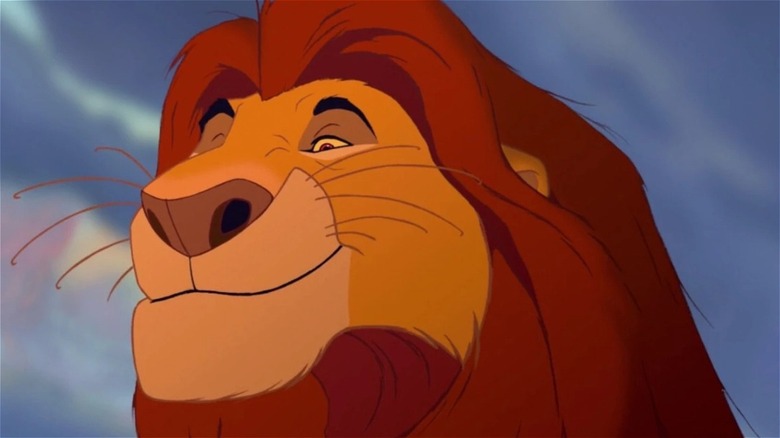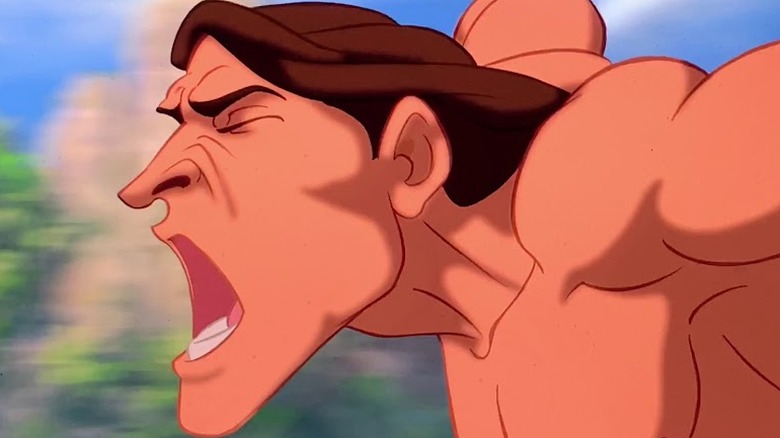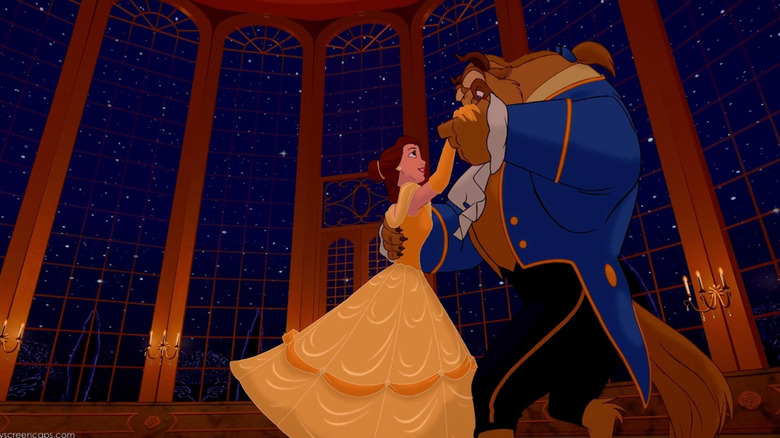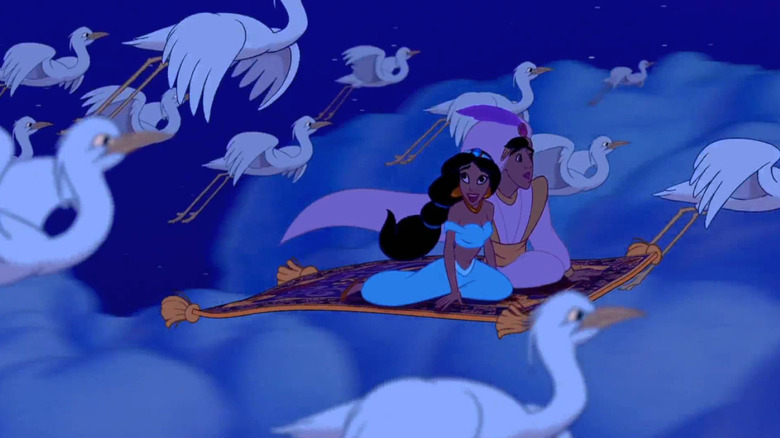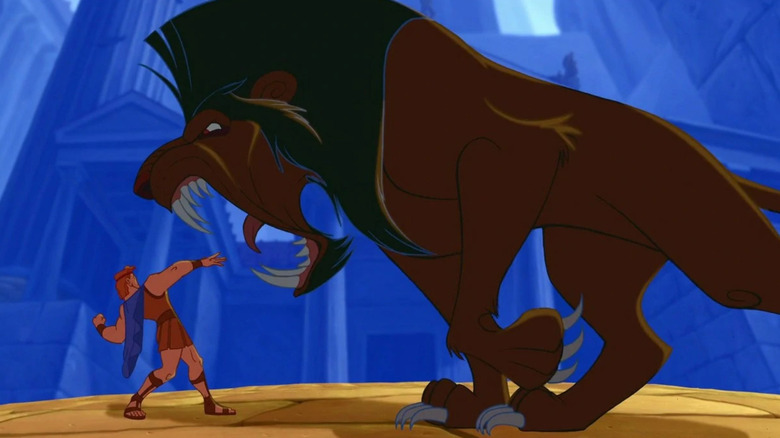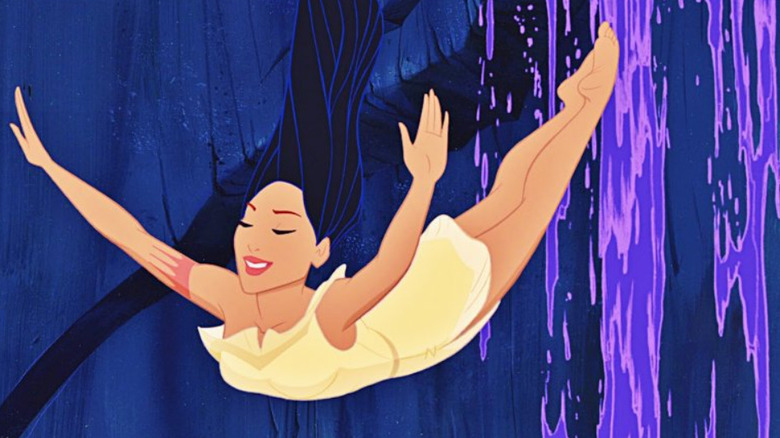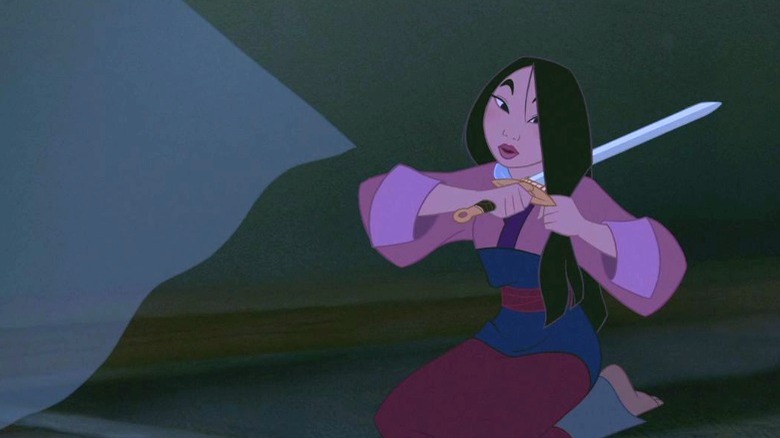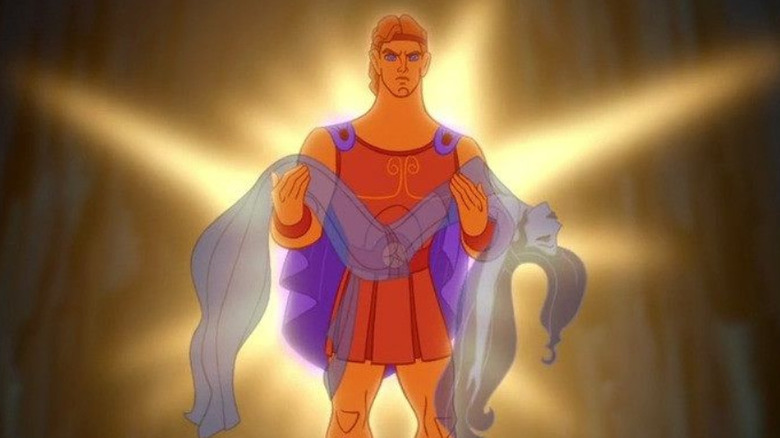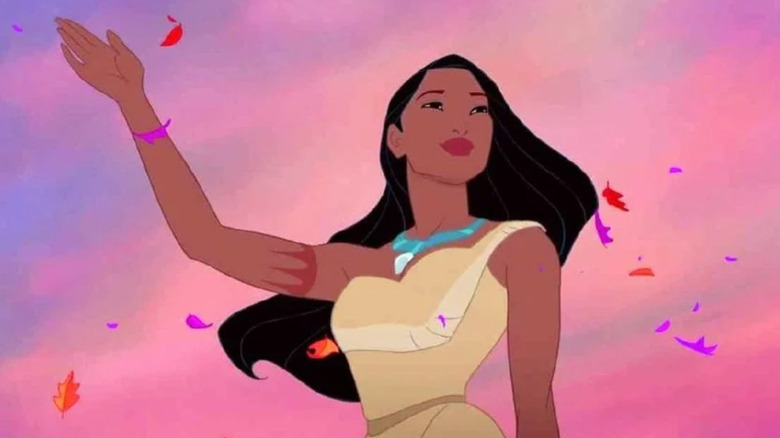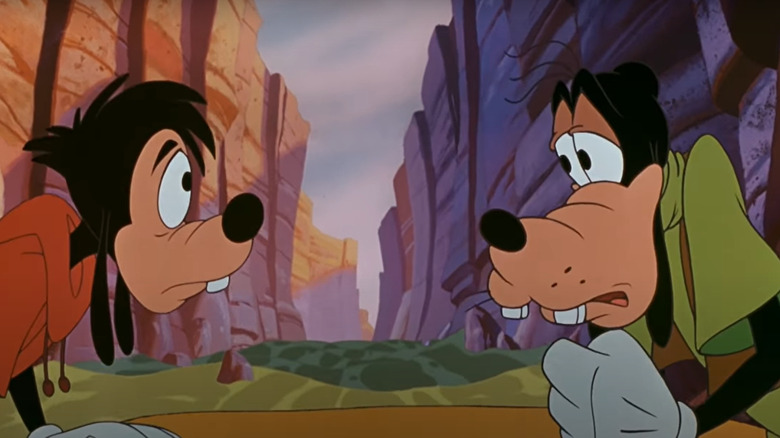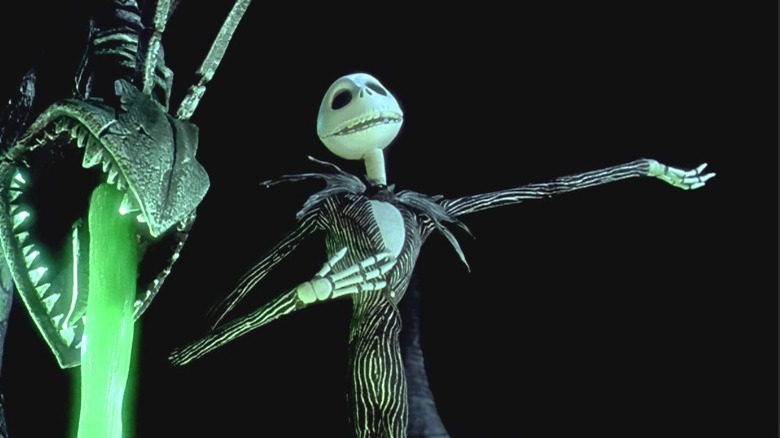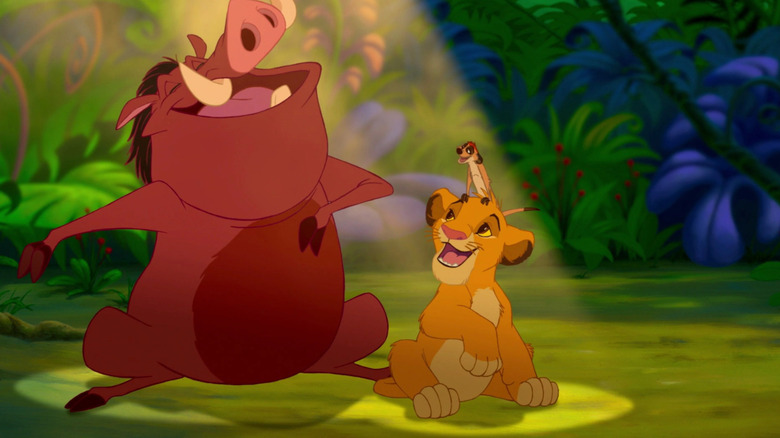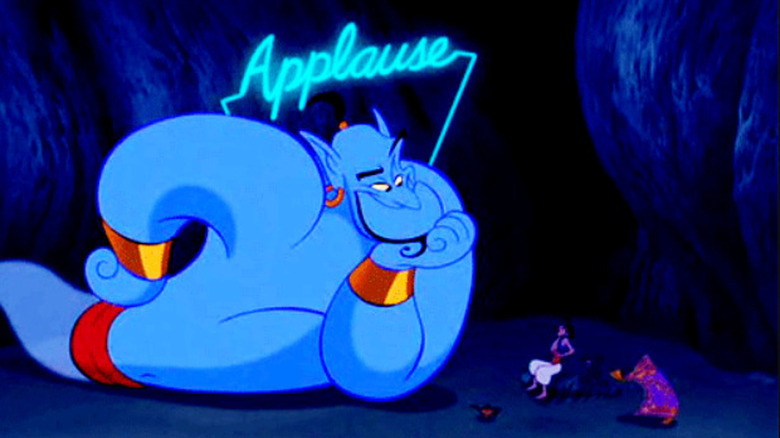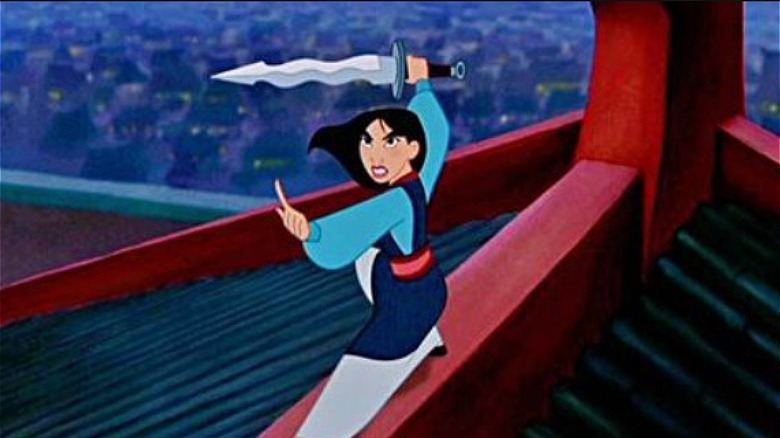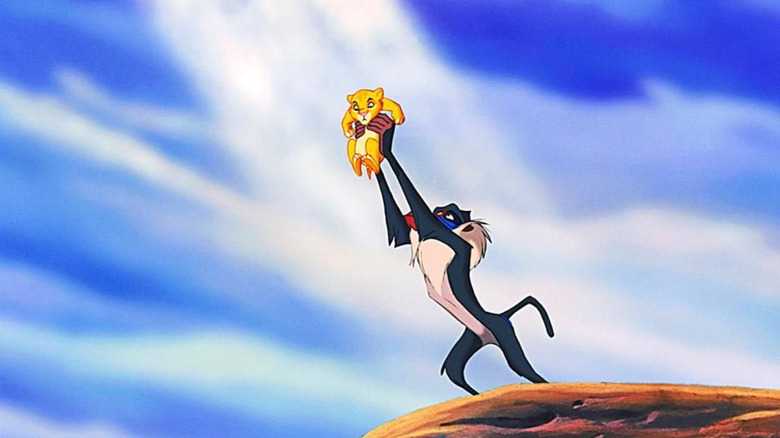The Most Iconic '90s Disney Movie Moments
What makes a movie scene iconic? How often it gets referenced in pop culture? How many memes and parodies it spawns on the internet? Or maybe how it comes to represent a defining point in time for generations of audiences? Whatever parameter you choose, Disney has a long history of cementing its status in pop culture by introducing such moments in its films.
The '90s were a particularly significant time for Disney movies. The Mouse Empire also took advantage of new innovations in the field of animation, as shows like "The Simpsons" made animated content more mainstream for older audiences. Movies like "The Lion King," "Aladdin," and "Beauty and the Beast" proved that Disney was prepared to stake its claim to this game-changing era with massively successful cinematic content.
Many of the Disney animated movies of that era continue to be hugely popular today, with specific moments from the films being reframed to fit modern pop culture themes. At other times, such moments are held up as the gold standard of Disney's storytelling ability from a bygone era. Here are 14 such iconic moments from 90's Disney movies that continue to strike a chord with fans.
Tarzan beats his chest
While Disney is best known for its leading princess characters, such as Snow White or Cinderella, the company has also churned out plenty of popular stories about male protagonists like Peter Pan, Hercules, and Aladdin. One of the most unexpected entries on the list is Tarzan, who got his own Disney film adaptation in 1999.
Like a more athletic Mowgli, the mighty King of the Apes zipped around his forest home using conveniently placed sliding tree branches and swung between vines like an immodestly-dressed Spider-Man. In addition, the movie also deeply explores Tarzan's relationship with his ape family and his feelings of hurt and isolation by not truly being seen as one of them. Even when Jane and the rest of the humans turn up, Tarzan is torn between his human and ape identities.
The fact that Tarzan is so attached to the apes makes it all the more satisfying when he does the one thing that the character is most famous for: beating his chest and letting out a gorilla roar. It is an iconic moment that countless Disney fans have imitated over the years.
Belle and the Beast dance together
Many eyebrows were raised when Disney first announced that it would be putting its own spin on the famous fairy tale of "Beauty and the Beast." While the tale is technically a love story, it also has some pretty gruesome elements, not to mention the Beast is a far cry from the traditional Disney archetype of the handsome and dashing prince.
Fortunately, Disney's "Beauty and the Beast" manages to make the Beast a sympathetic character, despite being a towering and fearsome figure prone to fits of rage. We follow Belle as she comes into contact with the Beast, first as an unwilling captive and later as an esteemed guest.
Sure, the relationship might come across as toxic to some viewers, but we do get to see all the little and big ways in which the Beast manages to change Belle's mind about him. This leads us to the iconic ballroom dance scene between Belle and the Beast, in which the two lost souls decked out in immaculate finery move together to a sweeping rhythm and fall in love in the process.
Aladdin takes Jasmine for a carpet ride
Given that Disney is known for its love stories, there are a lot of moments to choose from when it comes to showcasing the "Disney" method of wooing a princess. You can keep them in a cell, as the Beast did in "Beauty and the Beast." You can kiss their corpse, like in "Snow White." Or rub your noses together as Simba did with Nala in "The Lion King."
When it comes to wooing, the titular character from 1992's "Aladdin" would seem to be at a severe disadvantage. Aladdin was an ordinary street urchin who didn't have the resources even to meet Princess Jasmine, let alone try to woo her. Fortunately, thanks to his adventures in a magical cave, Aladdin got his hands on a wish-granting genie and a flying carpet that allowed him to get wildly creative with the whole wooing process.
As a result, Aladdin and Jasmine embarked on possibly the most romantic first date ever in Disney history. The two lovebirds flew over the city of Agrabah on Ali's magic carpet while crooning "A Whole New World" to each other. Sure, it's hard to believe they didn't accidentally swallow a bunch of bugs while flying at great speeds without a windshield, but the sequence remains an iconic '90s moment and one of the most memorable parts of the entire film.
Hercules gets a hero montage
Disney's 1997 feature "Hercules" is often overlooked when we talk about famous films from that era, perhaps for being too different from the rest of the Mouse Empire's stories about fairy tales and talking animals. But "Hercules" was a very well-made movie that also entertainingly reimagined the "Heracles" of legend as a superhero character.
In the movie, Hercules is a shy and bashful teenager who discovers that he is the son of Zeus, leader of the Greek Gods of Olympus. As a step towards fulfilling his destined godhood, Hercules trains with a Satyr named Phil to learn to harness his burgeoning powers. Unfortunately, the path to becoming a legend is paved with difficulties, especially when Hercules' uncle (and God of the Underworld) Hades is trying his hardest to keep his nephew from spoiling his plans for conquering Mount Olympus.
Once Hercules turns into a strapping young man, we get the iconic song montage "Zero to Hero," in which we see the God-in-training embarking on the "Disneyfied" versions of the "Twelve Labors of Hercules," while also establishing himself as a general do-gooder and man-of-the-people. The song was so popular that a version of it became the theme music for the spinoff show "Hercules: The Animated Series."
Pocahontas takes a dive
The '90s was an important period of change for the way Disney represented its princesses. After years of the generically white, thin, light-haired archetypes, the Mouse Empire finally gave fans princesses from different ethnicities, from Jasmine to Mulan and Pocahontas. For the last character, the studio looked to the real-life personality of the same name, who belonged to the Powhatan tribe during the time of the arrival of English colonial settlers from the Virginia Company (via History).
1995's "Pocahontas" takes a lot of liberties from the way the actual historical events of the time went down. But most of those changes are designed to make Pocahontas less of a victimized character and more in charge of her own destiny. Aside from making her older, the film is careful to give Pocahontas plenty of agency by depicting her as a strong and carefree soul with a deep sense of empathy and connection to nature.
Our first introduction to Pocahontas cements all these character traits in spectacular fashion. Instead of walking away from the cliff she had been standing on, Pocahontas chooses to take a dive off the edge of the cliff into the icy waters below while being surrounded by her forest friends. The image remains one of the most memorable from the movie and the kind of thing you could never imagine Cinderella or Snow White doing.
Mulan chops off her hair
If Jasmine and Pocahontas went against the idea that Disney princesses needed to be submissive damsels-in-distress, Mulan set fire to that idea and then cut it into tiny pieces with her sword. Sorry, Elsa, 1998's "Mulan" already gave us a badass empowered Disney princess who doesn't need to rely on a man to solve her problems more than a decade before you came along.
Based on the Chinese legend of Hua Mulan, the movie sees the titular character as a young girl who takes the place of her elderly father in the Chinese army while disguised as a boy. In one of the film's most dramatic moments, Mulan shows her resolve to go through with her very dangerous plan by willingly cutting off her long hair to complete her disguise as a male soldier.
The scene has many deeper themes in relation to feminism and a woman's place in a traditionally patriarchal society, and it resonated deeply with the audience. The recent live-action remake of "Mulan" chose to let the main character keep her long hair. The producer of the movie Jason Reed explained why to /Film, stating, "Chinese warriors, male warriors wore their hair long. Chinese men wore their hair long. For [Mulan] to cut her hair off, it would make her look more like a woman than less like a woman in reality."
Hercules becomes a god
The mythological story of Hercules' ascension into godhood is filled with so much violence and cruelty that it would find it hard to get even an R-rating from the censors. But when Disney adapted the story for their 1997 animated feature, they made the characters and his actions so genial that you could not help but root for Herc to ascend to Mount Olympus finally.
Much of the narrative drive of the movie is geared towards Hercules learning to move beyond his human limitations to become a true son of Zeus. In the climax of the film, the young hero, who is no longer imbued with his natural godliness, willingly jumps into the cursed waters of the river Styx to save the love of his life, Megara.
This leads to the most badass moment in the entire film. A rapidly dying Hercules' shriveled hand reaches tremblingly out from the river before becoming muscular again. He climbs out of Styx carrying Meg while bathed in a golden light. After proving his heroism and selflessness in being willing to sacrifice his life to save Meg, Hercules finds that his godhood has been restored, and he has truly joined the ranks of the other Greek Gods.
Pocahontas waves goodbye
When it comes to striking iconic poses that have been copied endlessly by social media cosplayers, most Disney Princesses have an impressive catalog. But arguably the best of the bunch is the one that Pocahontas strikes at the end of her first movie as she watches the ship carrying her love interest John Smith leave her land.
After a movie's worth of violence against her people, Pocahontas is faced with the prospect of leaving her land behind in order to go to England with John Smith. But she chooses to stay back, at least for now, to help keep the delicate peace between the various tribes that had come together to oppose the foreign settlers.
And so, with a heavy heart, Pocahontas stands atop the cliff and waves goodbye to John while colorful leaves dance around her in the air currents. The scene further accentuates Pocahontas' connection to nature and the parts of the world that do not belong to mankind while standing her apart from other Disney Princesses.
Goofy has a heart-to-heart with his son
1995's "A Goofy Movie" was not very well-received when it first came out. Despite the main character being known for his silly antics and slapstick comedy, the movie took a more somber approach to its story as Goofy takes his teenage son Max on a road trip to try to spend some quality time together and reconnect.
In later years, the themes of a generational gap and a lack of communication between parents and their children that "A Goofy Movie" explored came in for praise, and the film today has earned cult status among fans. One of the most heart-wrenching scenes in the movie that perfectly encapsulates its themes comes near the end when an accident sends Goofy's car down a turbulent river with Goofy and Max trapped on top.
As the river rages around them, the tensions between the two characters reach boiling point. Goofy accuses his son of lying to him, to which Max retorts that he was forced to do so because his father was "ruining his life" with his goofy antics. When Max declares that he is now a grown-up with his own life, Goofy looks resigned as he replies that he just wants to be a part of Max's life, adding, "No matter how big you get, you'll always be my son." There ain't nothing goofy about the character at that moment or the mix of shock and guilt on Max's face.
Introduction to Halloween Town
Tim Burton has made many successful movies over the years and carved out a highly distinct niche for his particular brand of gothic filmmaking. There is perhaps no movie that suits Burton's filmmaking sensibilities more closely than 1993's stop-motion animated classic "The Nightmare Before Christmas," and yet, the film wasn't even directed by Burton — although it was produced by him and was based on a poem Burton wrote years ago.
The film starts out with a bang, introducing us to the spooktacular world of "Halloween Town," the physical and geographical manifestation of the spirit of Halloween. The iconically eerie anthem of the holiday, "This is Halloween," starts playing in the background as the residents of Halloween Town make their presence felt. From white ghostly shadows to animated pumpkins, witches, and vampires to the nameless monster hiding under your bed, the song lets us know how seriously the movie takes the "Nightmare" part of its title.
In the final part of the song, we are introduced to the main lead of the story, Jack Skellington, the king of Halloween Town. He makes a splashy entrance as he sets himself on fire before throwing himself into the cursed waters of a decrepit old well. Since the film's release, "This is Halloween" has become a regular part of Halloween tradition, and the song has been covered by many famous artists, including Panic! at the Disco.
Learning to say Hakuna Matata
While the '90s gave us many popular Disney animated movies, there was one that towered over the rest both in terms of its financial success and the impact it had and continues to have on pop culture. 1994's "The Lion King," told the story of Simba, a young lion from the Pride Lands who must learn to grow into the role of the new king after his father Mufasa is killed by his scheming uncle Scar.
Before Simba embarks on his journey back to the Pride Lands, he spends a few years living in a distant forest with Timon and Pumba, his meerkat and wild boar buddies. To help Simba get over the losses he has suffered, Timon and Pumba teach him their philosophy of "Hakuna Matata."
It is an actual Swahili phrase that means "no worries," and as the comic duo sing, "it's our problem-free philosophy" to live a life of no worries or responsibilities. Thanks to the movie, "Hakuna Matata" became one of the most popular catchphrases of the '90s and still gets referenced decades later.
Genie is the only friend you will ever need
Has there ever been a more celebrated marriage between a Disney voice actor and their character than Robin Williams' inimitable take on the Genie in 1992's "Aladdin?" Williams was so good in the role, and the movie benefited so greatly from his involvement with regard to its publicity, that he is often credited with starting the trend of famous actors voicing cartoon characters over trained voice actors.
The viewers know they are in for something special from the moment the Genie first appears before Aladdin in the Cave of Wonders. To make his new master understand the mighty being that is now at his command, the Genie launches into his iconic introductory song, "Friend Like Me."
Over the course of nearly three minutes, Genie sings about all the wishes he could grant, the limitless power at his disposal, and all the ways he could help make Aladdin's life a paradise. The song's catchy beats coupled with the non-stop sight gags and references to modern pop culture in the spirit of a typical Robin Williams standup routine makes "Friend Like Me" an instant standout from the film.
Mulan fights Shan Yu
Disney Princesses are not known for their combat skills. Even the most empowered of the heroines like Elsa rely on magic to win fights rather than getting into fisticuffs. The most well-known exception to the rule is the titular character of 1992's "Mulan," who has no problem wielding a sword against an entire invading army of Huns and their fearsome leader Shan Yu.
During the climax of the movie, Mulan finally comes face-to-face with Shan Yu. It is clear that the Hun warlord is stronger and more experienced than the formidable Mulan, so she is forced to think on her feet and lay a trap. What follows is a desperate chase across the rooftops of ancient China with Shan Yu hot on the heels of Mulan.
At the last moment, the young heroine turns to face her attacker. Using her military skills, Mulan is able to wrest Shan Yu's sword from him and use it to force him into the path of a giant rocket. The entire sequence remains the coolest way a Disney heroine has ever taken down a villain using nothing but her skills and her brains.
Simba is presented to the world
Finally, we come to the most iconic Disney movie moment of the '90s, and quite possibly of all time. 1994's "The Lion King" had the difficult task of making audiences care about animals that behave like regular animals rather than anthropomorphic animals that look like humans wearing costumes.
To this end, the social structure of the Pride Lands that the main cast of the movie resides in was presented as an old-fashioned human kingdom with a royal dynasty and their subjects. This idea is beautifully encapsulated in the opening of the film. A crowd of animals of every shape and form gathers before a giant rock formation resembling a throne.
At the top of the rock stands Mufasa, the lion king of the Pride Lands, with his wife and his newborn son Simba. The wise old monkey Rafiki performs a coronation ceremony for the young prince and then presents Simba to his subjects by holding him aloft in front of them. The scene has been referenced or parodied in countless movies and shows since.
